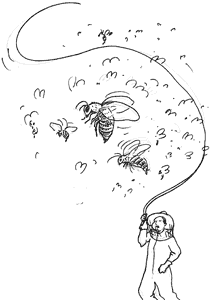STRANGE BUT TRUE- Roach rodeo: Managing those extra little pests

DRAWING BY DEBORAH DERR McCLINTOCK
Q. What's a bug wrangler do for a living? Hint: There may be a few "extras" inhabiting your kitchen. – F. Kafka
A. Wranglers provide and manipulate insects on movie sets, says May R. Berenbaum, in Bugs in the System, such as the 40,000 carpenter ants rounded up for an episode of Wonder Woman or the 3,000 locusts for Exorcist II.
Bees are probably easiest, since large numbers are available from hobbyists, and they respond en masse to pheromone scents, landing at the selected spot right on cue.
Roaches require more artful wrangling, says entomologist Raymond Mendez, who scared up some 5,000 for Joe's (infested) Apartment. For one scene, he knocked out a cockroach with carbon dioxide and inserted it, via special harness, into a carefully drilled doughnut hole. Revived by the sugary scent, the bit-part performer emerged on camera amidst the bedlam of a roomful of talking animated roaches.
Q. Just how loud do the cheering, jeering fans get at a pro football game? a) It's like being front row at a Kiss concert b) It's a tempest in a teacup c) The noise is psychologically intimidating as well as physically challenging d) The sound stays pretty well contained within the stadium, and not much out beyond. –A.G. Bell
A. Check all of the above. The loudest crowd ever recorded at a game, according to the Royal Association for Deaf People(!), was in 2000 in Denver, an un-domed stadium, says Timothy Gay in Football Physics. It registered 128.7 dB (decibels), beyond the threshold of pain for most people and comparable to 120 dB for a rock concert.
Imagine the Bronco fans could have kept this up for four full quarters– i.e., four hours of nonstop yelling at an energy flux of .5 pound-force feet per second per square foot, almost a trillion times more intense than the sound of normal breathing. Still, if you put a teacup of water at midfield, the sonic energy would raise the water temperature less than 3 degrees F (tempest in a teacup). What this shows is "the incredible sensitivity of the human ear."
As pure energy, the sound may not be much, but hearing 30,000 screaming hostile fans facing you in the end zone could put anybody off his game. Plus when the quarterback looks down the line at the receiver and audibles, he might as well be yelling into a jet engine. Nevertheless, says Gay, even at this volume, sound drop-off is so steep that by about half a mile from the stadium, crowd noise will be down to 80 dB, like traffic noise on a busy street.
Q. That everyday stuff you just put into the trash for pickup and disposal will still be undecomposed a) a year from now b) when your kids grow up c) when your kids' kids' kids'... grow up. –L. Tropea
A. A year will undo orange peels and many other organics, if not overly compacted in a landfill or shielded by a plastic bag, says Jessa Forte Netting in Discover magazine. Your kids will likely outlast the paper (five years), the plastic trash bag itself (10-20 years), and maybe the batteries (100 years). But for the glass bottles and plastic soda bottles, you'll need to tack on all the kids' kids' kids'... you can muster, because at a million years' decomposition time, the glass bottles may well outlast the human race itself. Still, the real endurance kings are plastic soda bottles, listed as "forever," making them immortal trash of sorts.
Q. A mathematician decides to create an interior house wall using randomly placed red, white, and black bricks, the design determined by a table of random numbers. Do you think her friends liked the novel brick wall? –T. Jefferson
A. They never saw it because she gave up on the idea. Soon after beginning, she noticed a large area with too many black bricks, says David G. Myers in Intuition: Its Powers and Perils. This would never do! Even though the bricks were indeed randomly placed, to her friends, the wall wouldn't have looked random at all. Yet the numbers table hadn't failed her. The problem is that when people imagine "random" arrangements, they overproduce alternations and underproduce streaks and clusters. Whether in coin tosses, sports, performance of mutual funds, random sequences seldom look random because they contain more streaks (black brick patches) than people expect.
Take a 50 percent basketball shooter: In any series of 20 shots (or 20 flips of a coin), there's a 50-50 chance of at least four baskets (or heads) in a row, and every fifth series on average will contain a streak of 5 or 6, by chance alone. "Players and fans notice these [random] streaks and so form the errant conclusion that when you're hot you're hot," says Myers.
In fact. there's no extra tendency for a player to hit a basket after having just made one, nor to miss after a previous miss. Hot/cold is not.
Send Strange questions to brothers Bill and Rich at [email protected].